Microwave Deicing Efficiency: Study on the Difference between Microwave Frequencies and Road Structure Materials
Abstract
1. Introduction
2. Mechanism Analysis
2.1. Microwave Heating Principle
2.2. Microwave Ice Melting Mechanism
3. Research Methods
3.1. Finite Element Simulation Model
3.2. Laboratory Experiments
4. Results and Discussion
4.1. Microwave Frequency
4.1.1. Simulation Research
4.1.2. Experimental Research
4.2. Pavement Structural Materials
4.2.1. Simulation Research
4.2.2. Experimental Research
5. Conclusions
- (1)
- Different microwave frequencies have a great influence on microwave de-icing efficiency. Under the same conditions, the microwave deicing efficiency of 5.8 GHz is 4.31 times that of 2.45 GHz, and microwaves with a frequency of 5.8 GHz are more suitable for pavement deicing.
- (2)
- At the same microwave frequency, the microwave absorption efficiency of different road structure materials is also different. The ice-melting efficiency of cement concrete is 3.89 times (2.45 GHz) and 5.23 times (5.8 GHz) that of asphalt concrete, respectively.
- (3)
- At the same frequency, the effect of a temperature increase of the microwave energy absorbed by cement concrete is better than that of asphalt concrete. The effect of microwave deicing on cement concrete pavement is better. Additionally, the higher the frequency is, the more obvious the difference in the microwave energy absorbed by cement concrete and asphalt concrete is.
- (4)
- As a new type of green deicing method, microwave deicing can overcome the shortcomings of traditional deicing methods, such as mechanical deicing and the chemical method, and it has a good development trend. We should pay more attention to the application of high frequency deicing and microwave deicing in cement concrete pavement. There are many factors that affect the deicing efficiency. If the multi-layer environment, such as air, ice, concrete, etc., and the thickness of each layer can be fully considered, this paper will be more complete. Next, we will further study the output power and different ice thicknesses at the same frequency.
Author Contributions
Funding
Conflicts of Interest
References
- Wang, X.C.; Lu, K.Q. Technology and Development of Snow Melting Ice on Highways. Road Mach. Constr. Mech. 2013, 30. [Google Scholar] [CrossRef]
- Hu, Z.D.; Du, S.R.; Shen, B.C.; Wang, L.H. Mechanical property analysis on cutting tool of the ice and snow removing machine based on ANSYS. Appl. Mech. Mater. 2015, 779, 74–79. [Google Scholar] [CrossRef]
- Zhu, Z.C.; Zhang, X.J.; Mou, G.L.; Li, C.X.; You, J. Design and experiment of thermal water and mechanical deicing device. Appl. Mech. Mater. 2014, 532, 311–315. [Google Scholar] [CrossRef]
- Trenouth, W.R.; Gharabaghi, B.; Perera, N. Road salt application planning tool for winter de-icing operations. J. Hydrol. 2015, 524, 401–410. [Google Scholar] [CrossRef]
- Pan, P.; Wu, S.; Xiao, Y.; Liu, G. A review on hydronic asphalt pavement for energy harvesting and snow melting. Renew. Sustain. Energy Rev. 2015, 48, 624–634. [Google Scholar] [CrossRef]
- Wu, Z.; Deng, B.; Liu, J.; Zeng, B. Highly efficient microwave heating for target area based on metamaterial. Microw. Opt. Technol. Lett. 2017, 59, 758–761. [Google Scholar] [CrossRef]
- Wang, C.H.; Wang, S.; Li, Q.J. Fabrication and performance of a power generation device based on stacked piezoelectric energy-harvesting units for pavements. Energy Convers. Manag. 2018, 163, 196–207. [Google Scholar] [CrossRef]
- Jie, G.; Zhang, Z.W.; Han, Z.Q.; Sha, A.M.; Wang, Z.J.; Jiang, W. A Review of Electromagnetic Wave Absorbing Materials Used in Microwave Deicing Pavement. Mater. Rev. 2016, 30, 87–95. (In Chinese) [Google Scholar]
- Chen, H.; Wu, Y.; Xia, H.; Zhang, Z.; Yuan, T. Anti-freezing asphalt concrete: ice-adhesion performance. J. Mater. Sci. 2018, 53, 4781–4795. [Google Scholar] [CrossRef]
- Buttress, A.J.; Jones, D.A.; Dodds, C.; Dimitrakis, G.; Campbell, C.J.; Dawson, A.; Kingman, S.W. Understanding the scabbling of concrete using microwave energy. Cem. Concr. Res. 2015, 75, 75–90. [Google Scholar] [CrossRef]
- Wang, C.; Yang, B.; Tan, G.; Guo, X.; Zhou, L.; Xiong, S. Numerical analysis on thermal characteristics and ice melting efficiency for microwave deicing vehicle. Mod. Phys. Lett. B 2016, 30. [Google Scholar] [CrossRef]
- Lu, S.; Xu, J.; Bai, E.; Liu, J.; Luo, X. Investigating microwave deicing efficiency in concrete pavement. RSC Adv. 2017, 7, 9152–9159. [Google Scholar] [CrossRef]
- Lindroth, D.P.; Berglund, W.R.; Wingquist, C.F. Microwave thawing of frozen soils and gravels. J. Cold Reg. Eng. 1995, 9, 53–63. [Google Scholar] [CrossRef]
- Ye, M.; Li, Y.; He, Y.; Daneshmand, M. Study of multipactor suppression of microwave components using perforated waveguide technology for space applications. Phys. Plasm. 2017, 24, 052109. [Google Scholar] [CrossRef]
- Guan, M.H.; Xu, Y.G.; Lu, T.J.; Xu, C.H. Application of microwave heating technology in clearing road icing. J. Beijing Jiaotong Univ. 2003, 27, 79–83. [Google Scholar] [CrossRef]
- Li, X.; Xu, Y.G.; Liu, F.L. Microwave deicing method research. J. Harbin Inst. Technol. 2003, 35, 1342–1343. (In Chinese) [Google Scholar] [CrossRef]
- Hopstock, D.M. Microwave-absorbing road construction and repair material. In Final Report to NRRI on Idea Evaluation Subcontract.; Intelligent Transportation Systems Institute, Center for Transportation Studies, University of Minnesota: Twin-Cities, MN, USA, 2003. [Google Scholar]
- Wang, Z.; Wang, H.; An, D.; Ai, T.; Zhao, P. Laboratory investigation on deicing characteristics of asphalt mixtures using magnetite aggregate as microwave-absorbing materials. Constr. Build. Mater. 2016, 124, 589–597. [Google Scholar] [CrossRef]
- Tang, X.W.; Jiao, S.J.; Gao, Z.Y.; Wang, Q. Efficiency analysis on microwave-enabled road deicing in winter. Chin. J. Constr. Mach. 2008. [Google Scholar] [CrossRef]
- Tang, X.W.; Jiao, S.J.; Gao, Z.Y.; Xu, X.L. Study of 5.8 GHz magnetron in microwave deicing. J. Electromagn. Waves Appl. 2008, 22, 1351–1360. [Google Scholar] [CrossRef]
- Ding, S.; Jia, B.; Li, F.; Zhu, Z.; Zhang, G.; Wang, C.; Zhong, L. Analysis of the energy output system for 5.8 GHz magnetron. J.Electromagn. Waves Appl. 2008, 22, 1539–1546. [Google Scholar] [CrossRef]
- Tang, X.W.; Jiao, S.J.; Gao, Z.Y.; Xu, X.L. Study of 5.8 GHz magnetron in asphalt pavement maintenance. J. Electromagn. Waves Appl. 2008, 22. [Google Scholar] [CrossRef]
- Jiao, S.J.; Tang, X.W.; Gao, Z.Y.; Wang, Q.W. Study of key technology on microwave deicing efficiency. China J. Highw. Transp. 2008, 21, 121–126. [Google Scholar] [CrossRef]
- Hopstock, D.M. Minnesota Taconite as a Microwave-Absorbing Road Aggregate Material for Deicing and Pothole Patching Applications; Final Report; University of Minnesota: Twin Cities, MN, USA, 2004. [Google Scholar]
- Zanko, L.M.; Niles, H.B.; Oreskovich, J.A. Mineralogical and microscopic evaluation of coarse taconite tailings from Minnesota taconite operations. Regul. Toxicol. Pharmacol. 2008, 52, S51–S65. [Google Scholar] [CrossRef] [PubMed]
- Chen, Y.; Guo, D.; Sha, A. Magnetic iron ore using as microwave-absorbing material for deicing of asphalt pavement. Min. Res. Dev. 2013. [Google Scholar] [CrossRef]
- Gao, J.; Zhang, Z.; Han, Z.; Sha, A.; Wang, Z.; Jiang, W. A review of electromagnetic wave absorbing materials used in microwave deicing pavement. Mater. Rev. 2016. [Google Scholar] [CrossRef]
- Gao, J.; Sha, A.; Wang, Z.; Tong, Z.; Liu, Z. Utilization of steel slag as aggregate in asphalt mixtures for microwave deicing. J. Clean. Prod. 2017, 152, 429–442. [Google Scholar] [CrossRef]
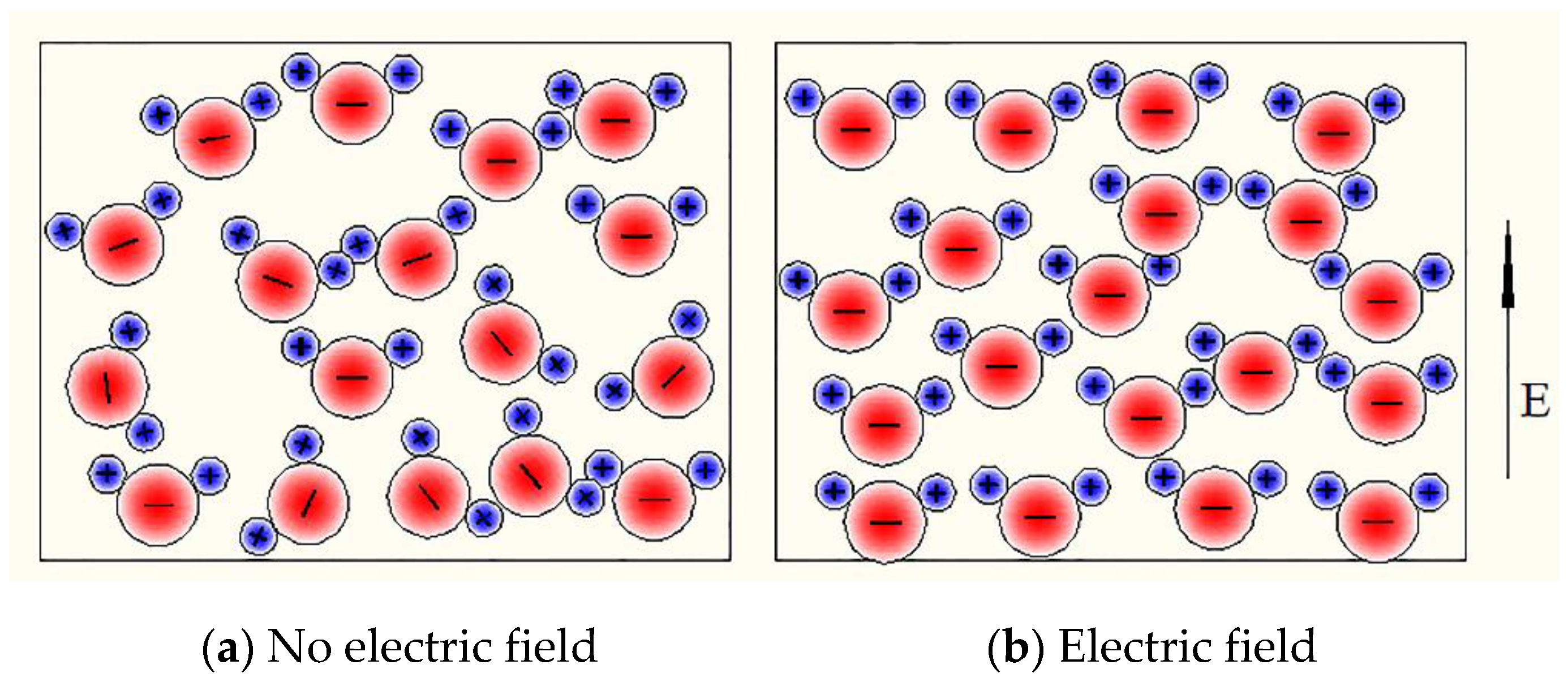
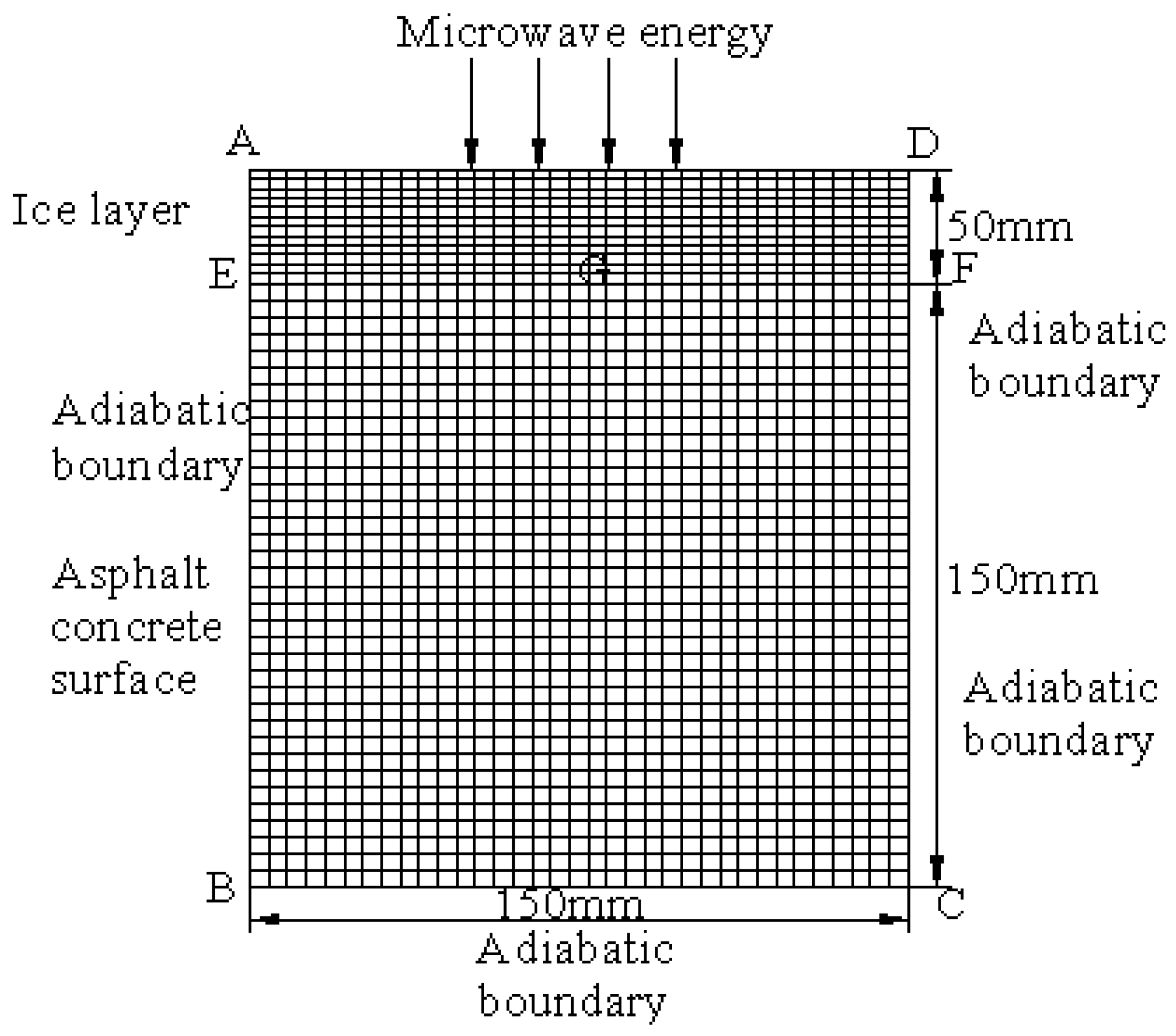
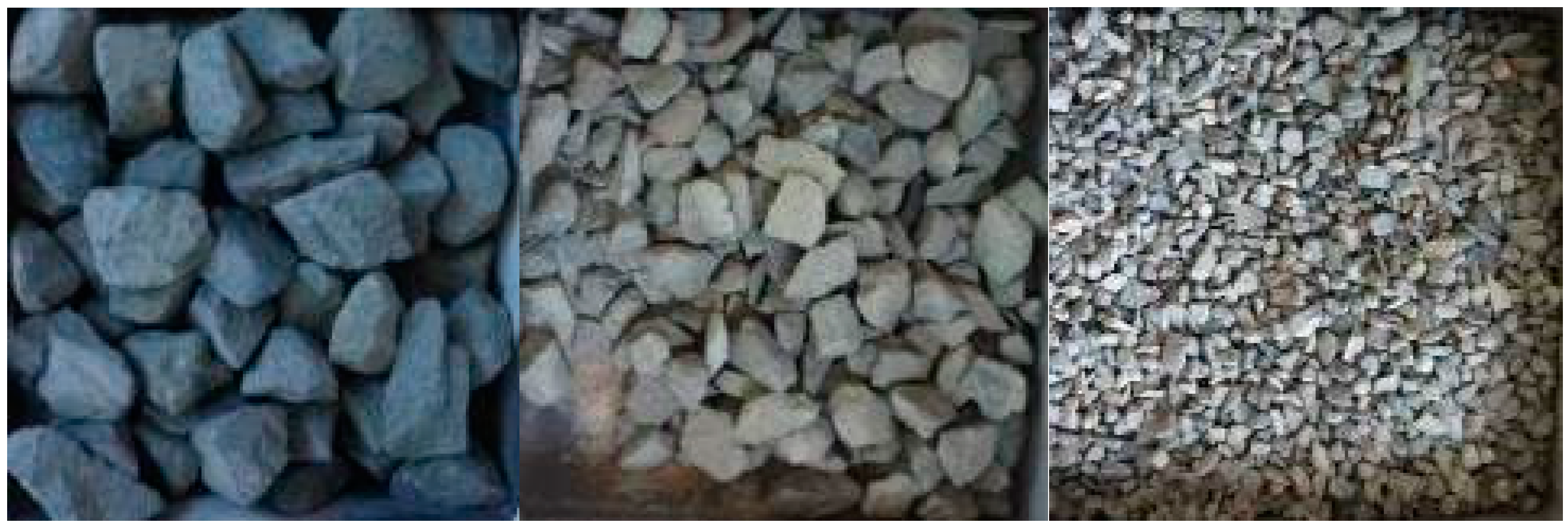
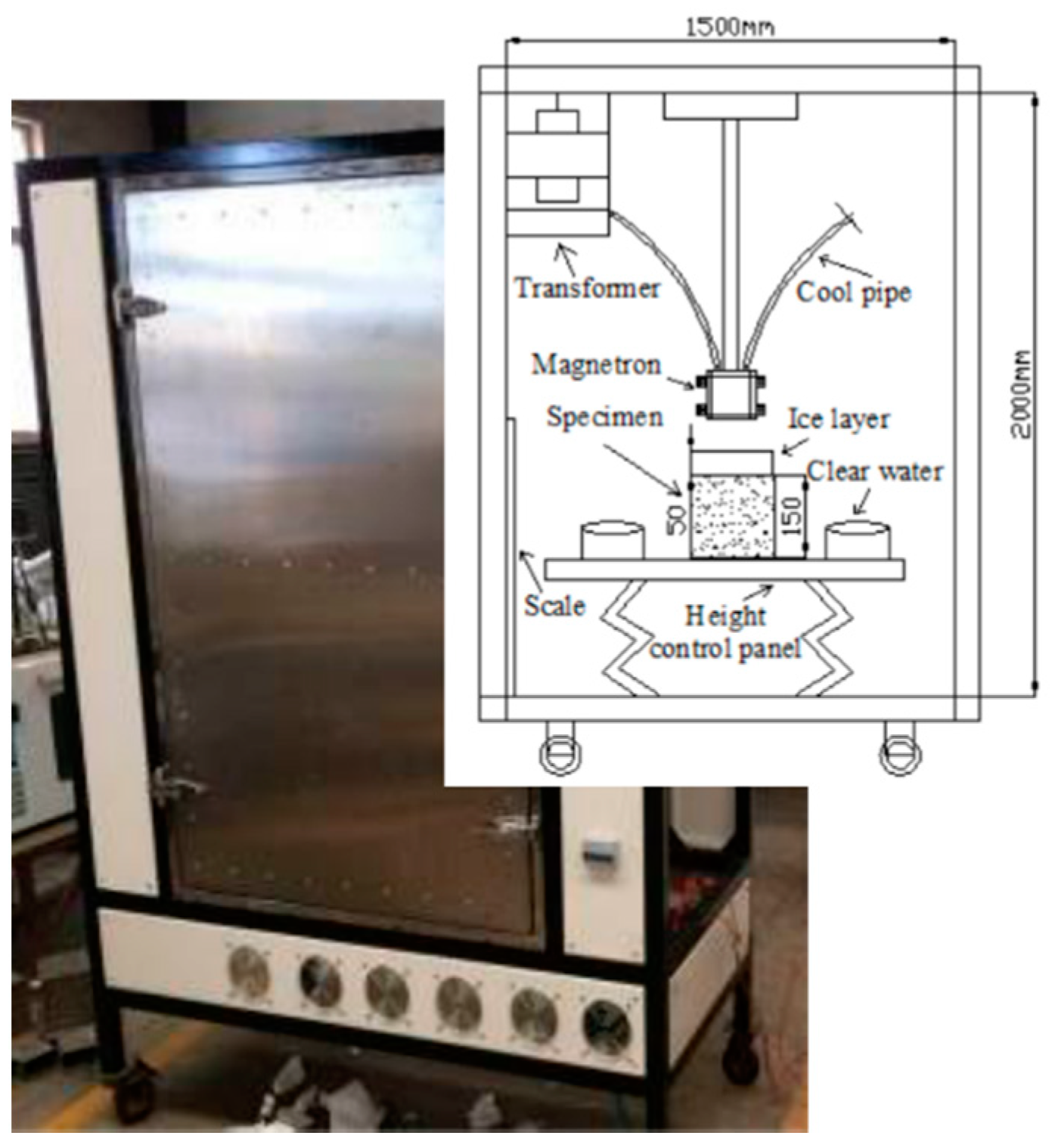
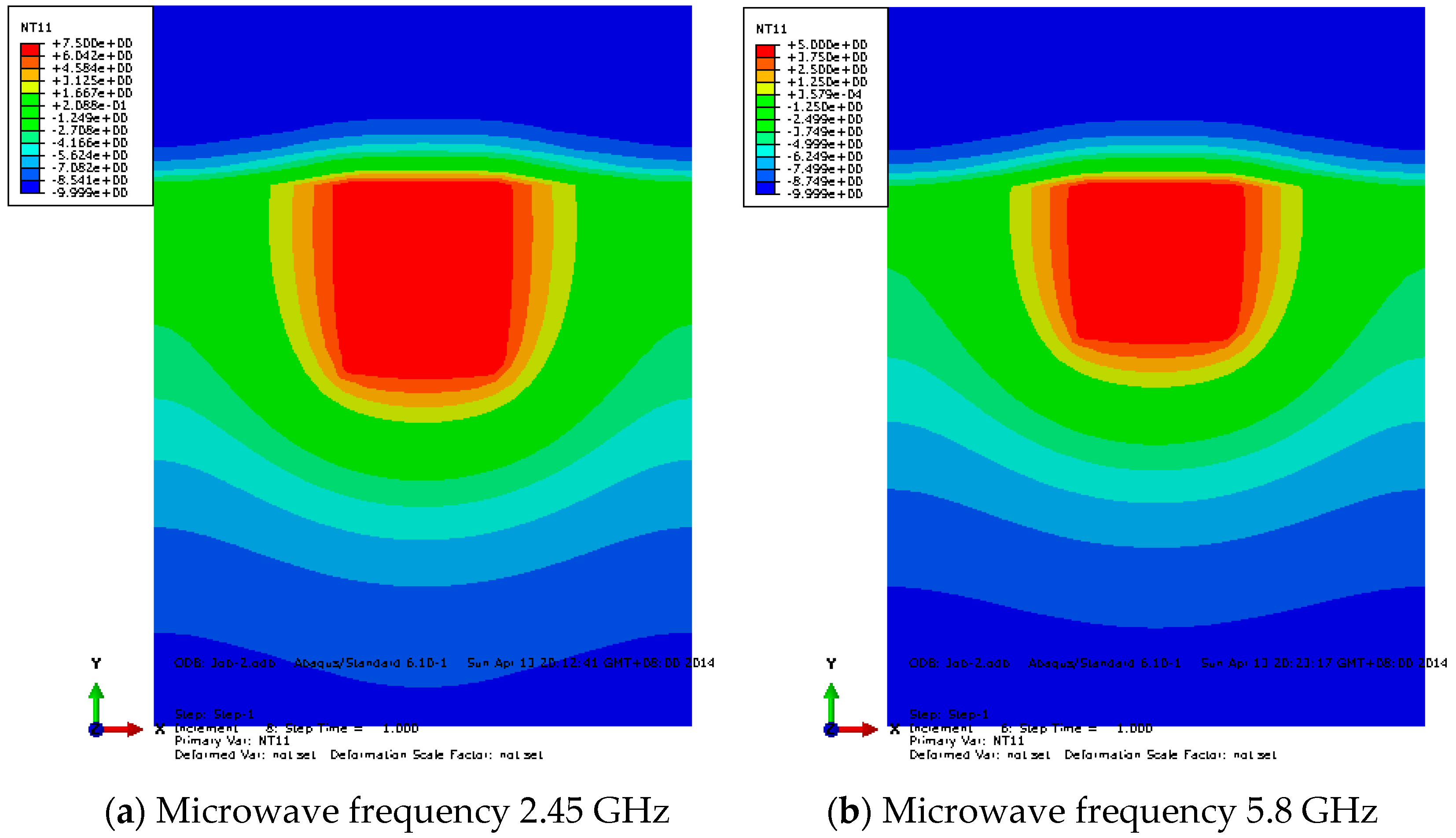
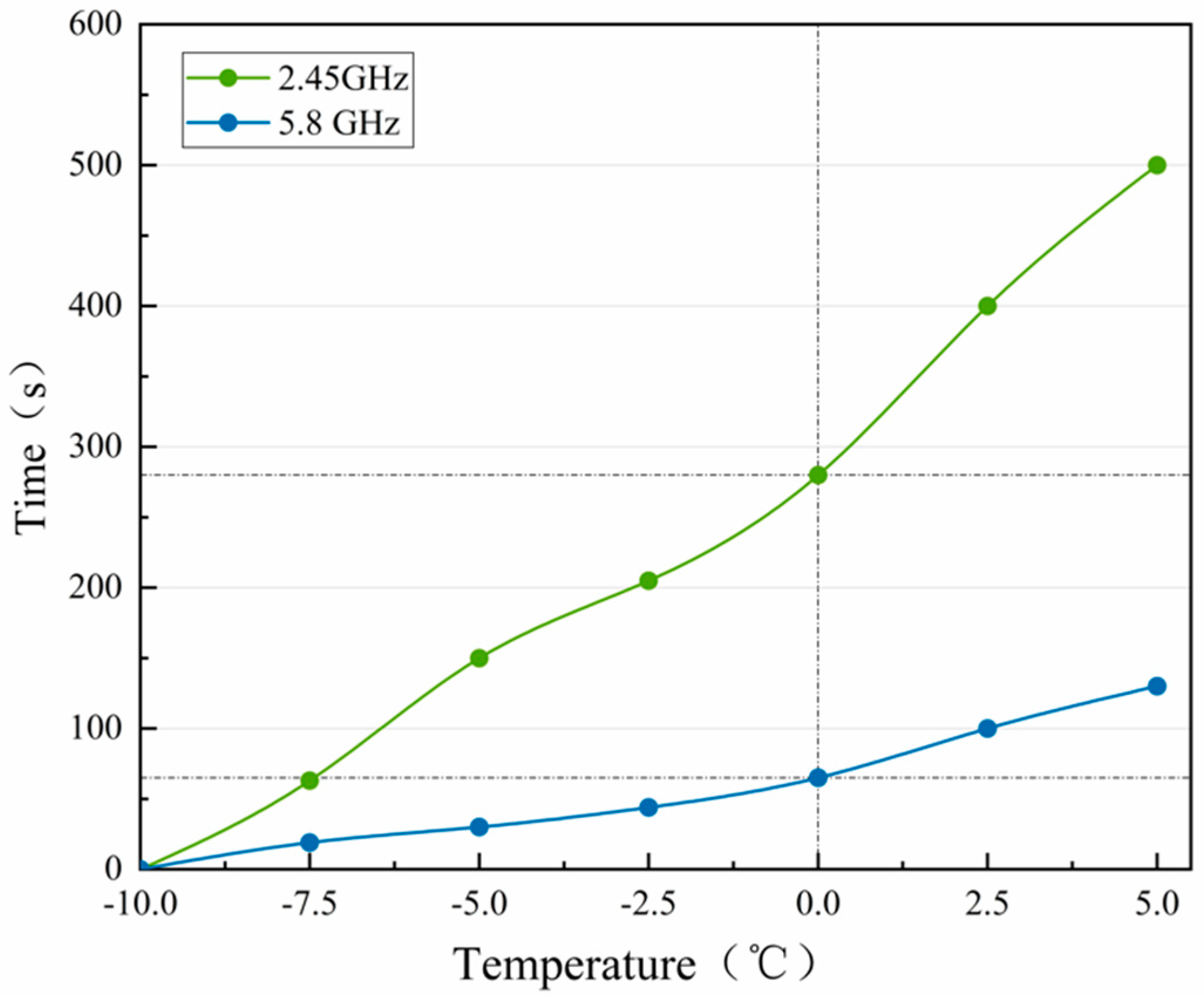
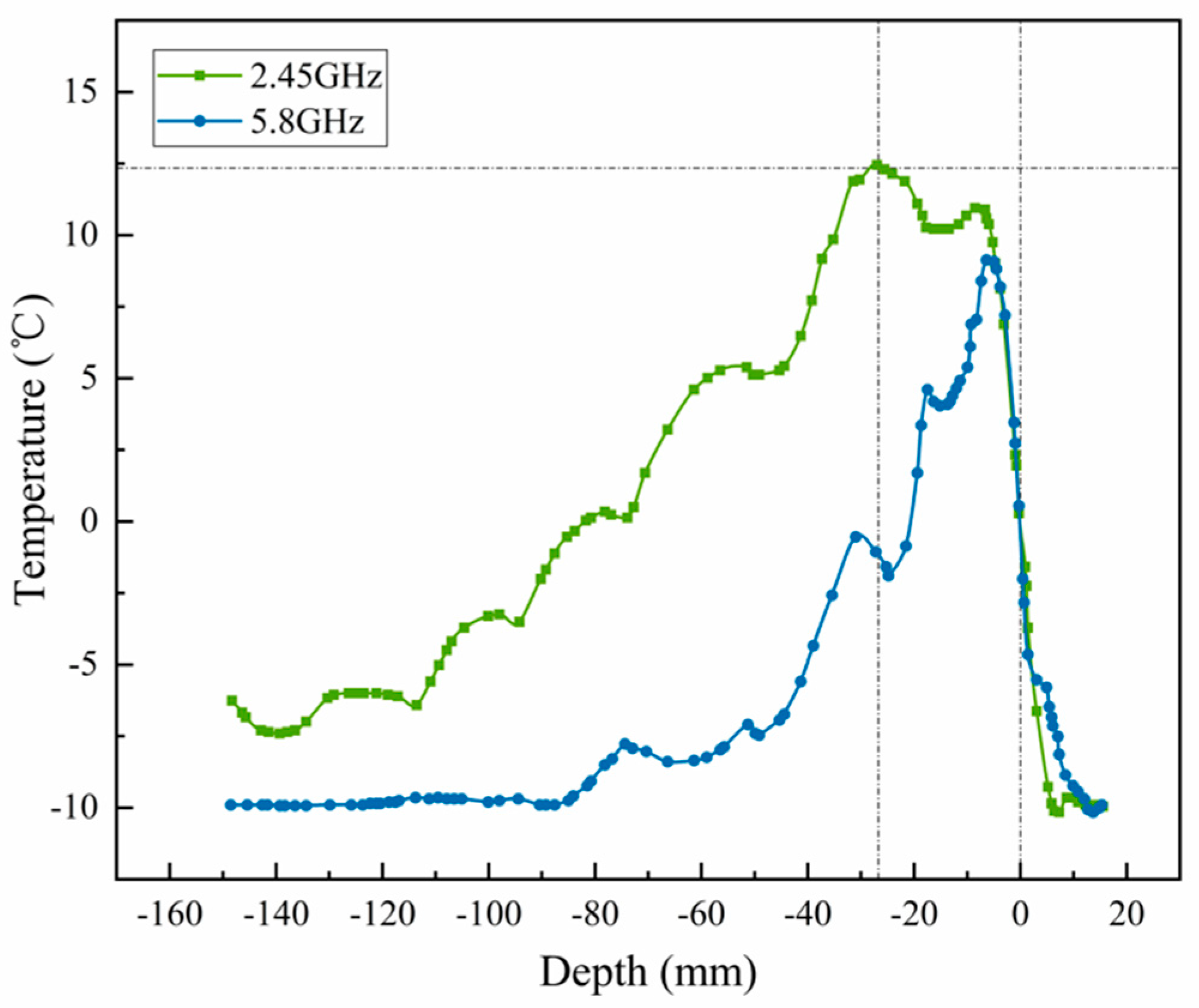
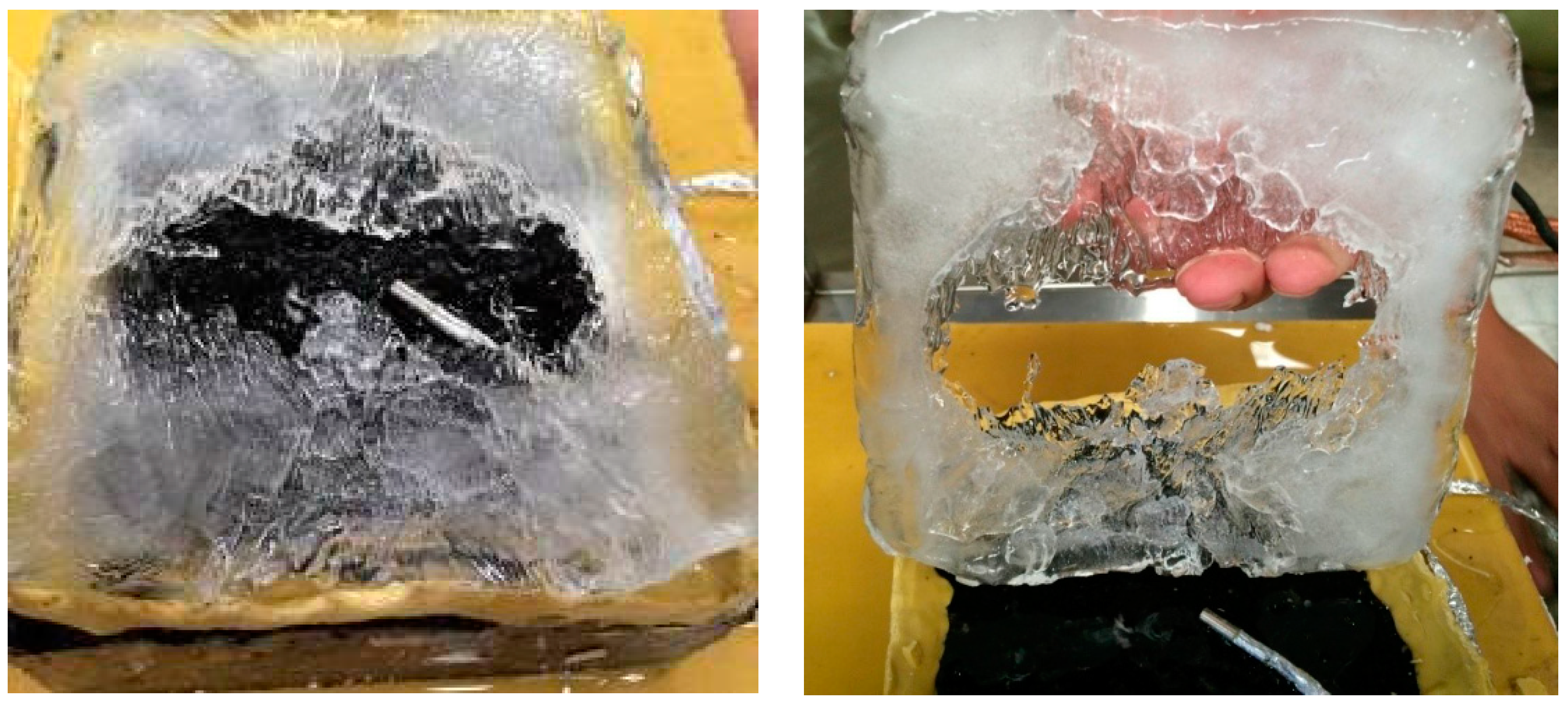
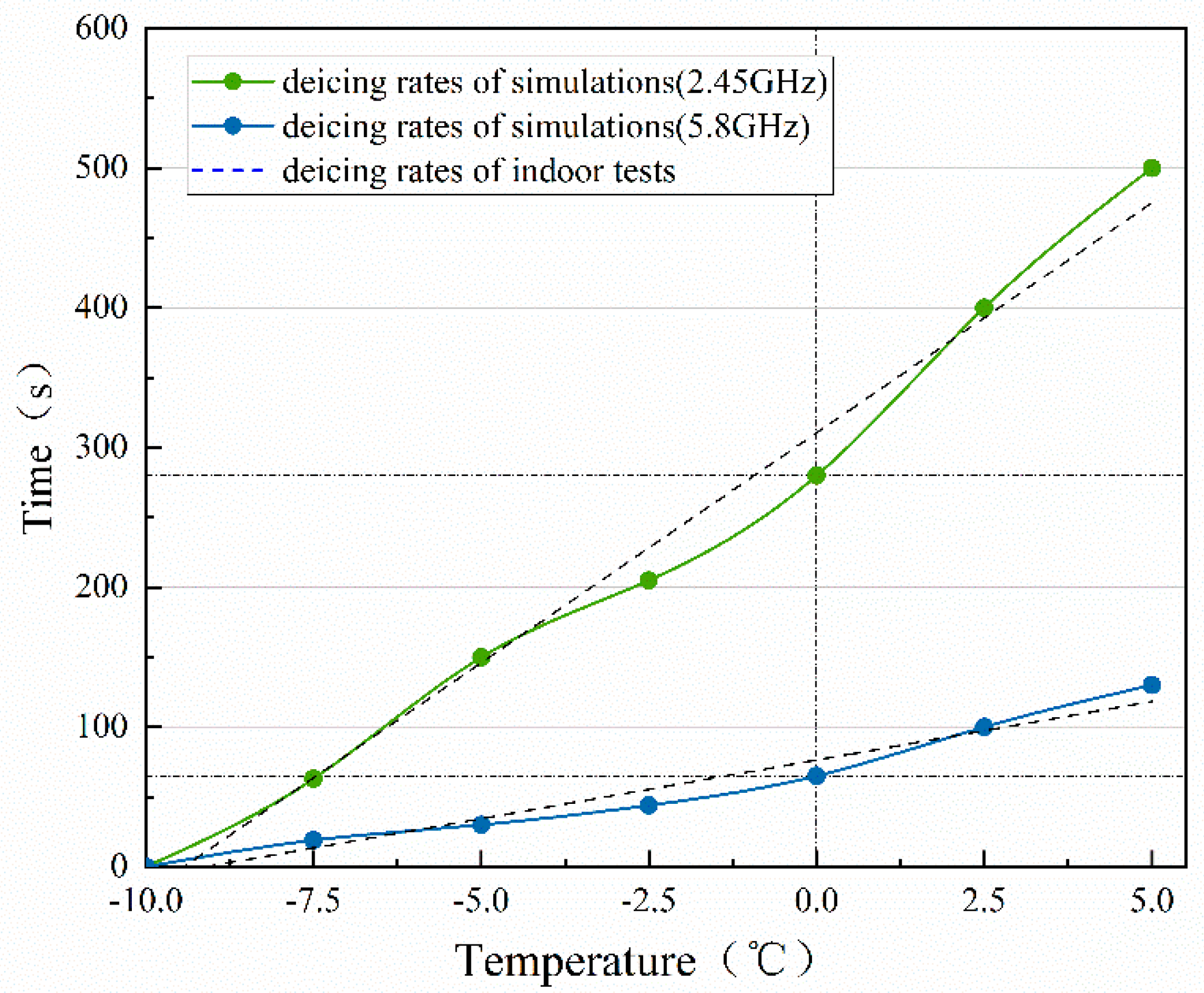
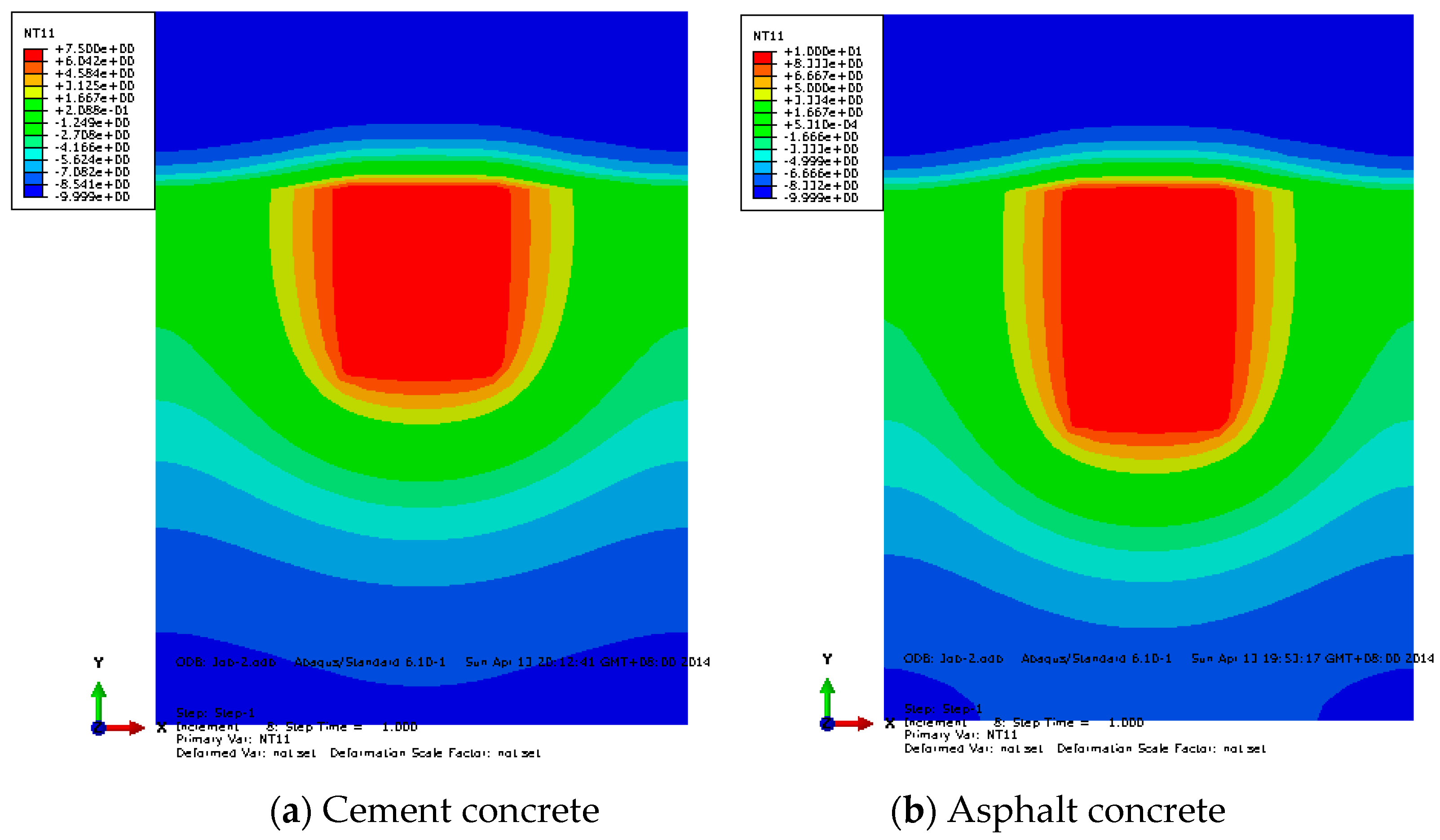
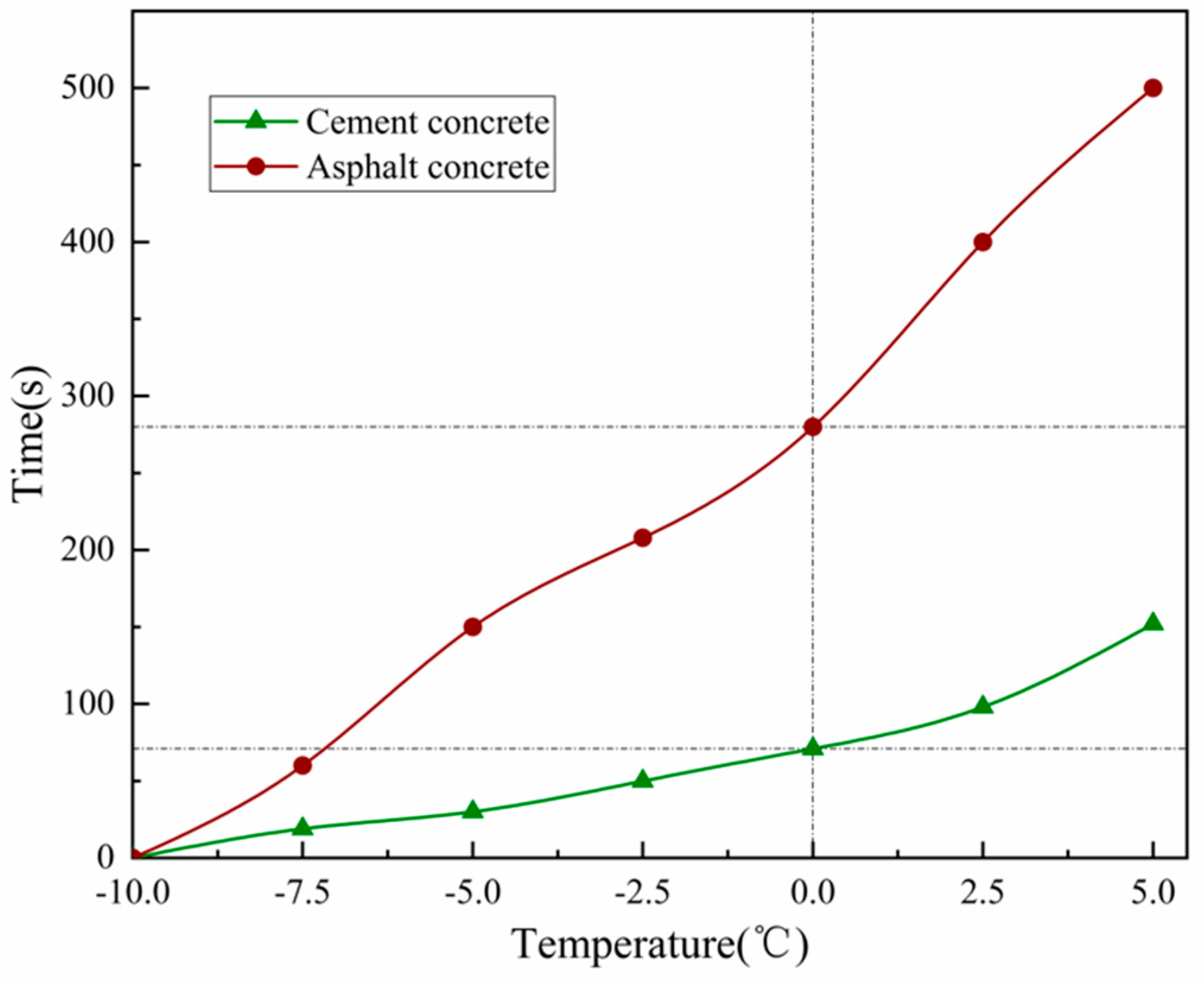

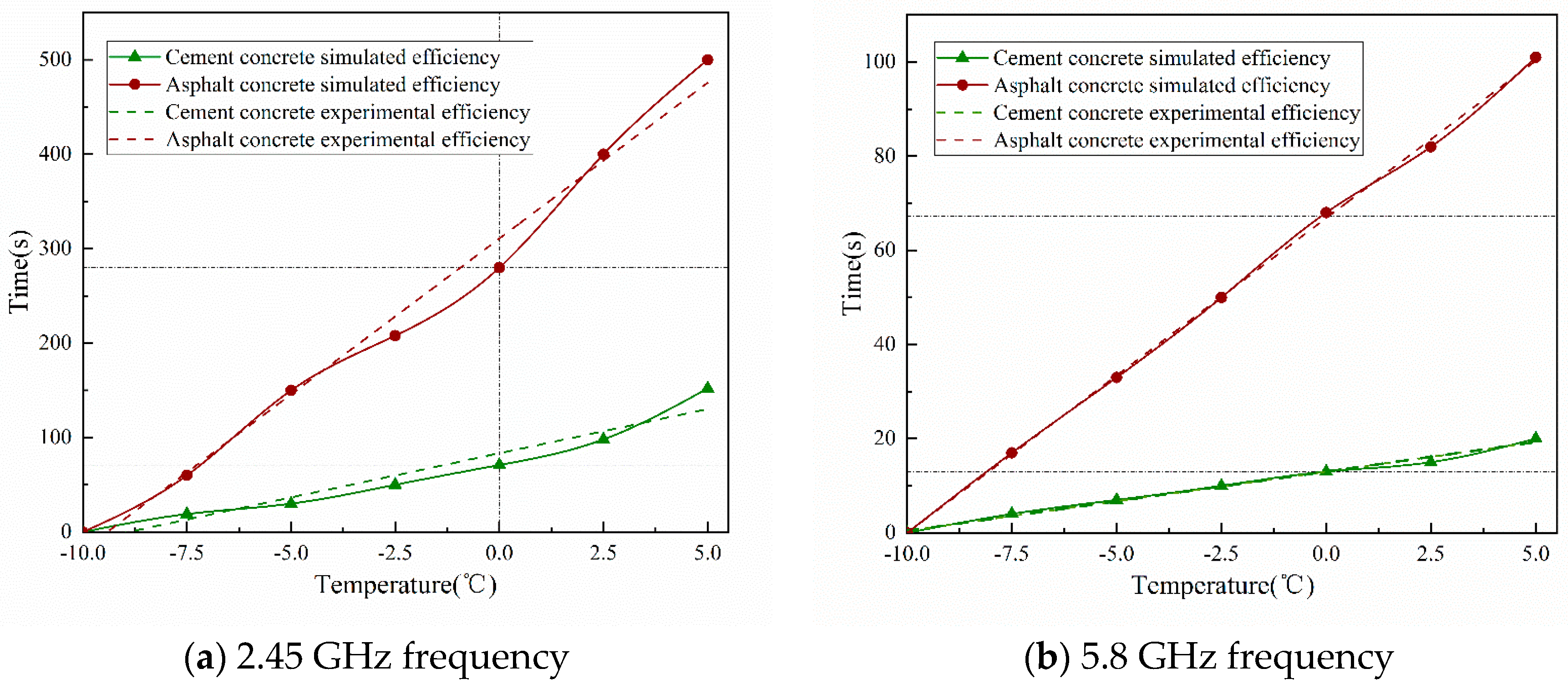
| Material | Relative Dielectric Constant | Loss Angle Constant |
|---|---|---|
| Water | 76.7 | 0.157 |
| Ice | 3.2 | 0.0009 |
| Asphalt concrete | 4.5–6.5 | 0.015–0.036 |
| Cement concrete | 8 | 0.048 |
| Material Type | Density kg/m3 | Conductivity Coefficient W/(m·°C) | Specific Heat Capacity J/kg·°C |
|---|---|---|---|
| Water | 1000 | 0.6 | 4200 |
| Ice | 920 | 2.31 | 2100 |
| Asphalt concrete | 2350 | 0.55 | 2090 |
| Cement concrete | 2300 | 1.8 | 880 |
| Grading Type | The Quality Percentage Passing through the Following Mesh (mm) | |||||||||
|---|---|---|---|---|---|---|---|---|---|---|
| 16.0 | 13.2 | 9.5 | 4.75 | 2.36 | 1.18 | 0.6 | 0.3 | 0.15 | 0.075 | |
| Percentage (%) | 100 | 95 | 76 | 53 | 37 | 26 | 19 | 14 | 10 | 6 |
| Test Index | The Technical Requirements of Aggregate | Test Results | Experiment Method |
|---|---|---|---|
| Crush value (%) | 26% | 9.8 | T 0316-2005 |
| Apparent relative density (t/m3) | 2.6 | 3.88 | T 0304-2005 |
| Water absorption (%) | 2.0 | 0.23 | T 0304-2005 |
| Adhesion | Level5 | Level5 | T 0616-2000 |
| Sturdiness (%) | 12% | 0.8 | T 0314-2000 |
| Needle and plate particle content (mixture) (%) The particle size is greater than 9.5 mm (%) The particle size is less than 9.5 mm (%) | 15% 12% 18% | 5.2 3.1 5.9 | T 0312-2005 |
| PSV | 42 | 48 | T 0321-2005 |
| Test Index | The Technical Requirements of Aggregate | Test Results | Experiment Method |
|---|---|---|---|
| Bulk volume density | / | 2.79 | T0330-2005 |
| Apparent relative density | ≥2.5 | 2.763 | T0328-2005 |
| Water absorption | 2.0 | 0.53 | T 0330-2005 |
| Sand equivalent | ≥70 | 73 | T 0334-2005 |
| <0.075 mm Content (%) | ≤15 | 9.8 | T 0327-2000 |
| Angularity (s) | ≥30 | 46.7 | T 0345-2000 |
| Frequency (GHz) | Range (MHz) | Market Average Price (CNY) | Penetration Depth |
|---|---|---|---|
| 2.45 | ±50 | 100 | Deeper |
| 5.8 | ±75 | 10,000 | Lighter |
| Parameters | 2.45 GHz | 5.8 GHz | ||||
|---|---|---|---|---|---|---|
| 1 | 2 | 3 | 1 | 2 | 3 | |
| Initial temperature/°C | −14.3 | −15.8 | −13.6 | −14.8 | −14.5 | −13.6 |
| Heating time/S | 423 | 523 | 413 | 105 | 95 | 89 |
| Temperature-rise rate/(°C S−1) | 0.034 | 0.030 | 0.033 | 0.141 | 0.153 | 0.153 |
| Parameters | Cement Concrete | Asphalt Concrete | ||||
|---|---|---|---|---|---|---|
| 1 | 2 | 3 | 1 | 2 | 3 | |
| Initial temperature/°C | −13.8 | −14.6 | −12.9 | −14.5 | −15.2 | −12.4 |
| Heating time/s | 105 | 116 | 112 | 443 | 475 | 448 |
| Temperature-rise rate/(°C S−1) | 0.131 | 0.126 | 0.115 | 0.033 | 0.032 | 0.028 |
| Parameters | Cement Concrete | Asphalt Concrete | ||||
|---|---|---|---|---|---|---|
| 1 | 2 | 3 | 1 | 2 | 3 | |
| Initial temperature/°C | −13.5 | −14.3 | −14.5 | −15.1 | −14.6 | −14.3 |
| Heating time/s | 19 | 20 | 20 | 109 | 104 | 110 |
| Temperature-rise rate/(°C S−1) | 0.711 | 0.715 | 0.725 | 0.139 | 0.140 | 0.130 |
© 2018 by the authors. Licensee MDPI, Basel, Switzerland. This article is an open access article distributed under the terms and conditions of the Creative Commons Attribution (CC BY) license (http://creativecommons.org/licenses/by/4.0/).
Share and Cite
Ding, L.; Wang, X.; Zhang, W.; Wang, S.; Zhao, J.; Li, Y. Microwave Deicing Efficiency: Study on the Difference between Microwave Frequencies and Road Structure Materials. Appl. Sci. 2018, 8, 2360. https://doi.org/10.3390/app8122360
Ding L, Wang X, Zhang W, Wang S, Zhao J, Li Y. Microwave Deicing Efficiency: Study on the Difference between Microwave Frequencies and Road Structure Materials. Applied Sciences. 2018; 8(12):2360. https://doi.org/10.3390/app8122360
Chicago/Turabian StyleDing, Longting, Xuancang Wang, Wengang Zhang, Shuai Wang, Jing Zhao, and Yongquan Li. 2018. "Microwave Deicing Efficiency: Study on the Difference between Microwave Frequencies and Road Structure Materials" Applied Sciences 8, no. 12: 2360. https://doi.org/10.3390/app8122360
APA StyleDing, L., Wang, X., Zhang, W., Wang, S., Zhao, J., & Li, Y. (2018). Microwave Deicing Efficiency: Study on the Difference between Microwave Frequencies and Road Structure Materials. Applied Sciences, 8(12), 2360. https://doi.org/10.3390/app8122360






